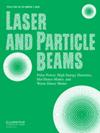黏度对带电粒子在二维电子气体上方运动时停止力的影响
IF 1.9
4区 物理与天体物理
Q4 PHYSICS, APPLIED
引用次数: 0
摘要
在二维电子系统中,当电子-电子碰撞比杂质或声子散射发生得更频繁时,粘性流动占主导地位。在这项工作中,提出了一个考虑粘性的量子流体力学模型来研究在二维粘性电子气体上运动的带电粒子的相互作用。理论分析和数值计算了停止功率、微扰电子气体密度和速度矢量场的空间分布。计算结果表明,黏度会影响速度场的空间分布和振幅。计算出了描述离子与二维电子气相互作用的必要量——停止功率,表明二维电子气中动态电子极化和感应电场随着粘度的减弱而减弱,入射粒子的能量损失较小。在考虑了粘度的影响后,停止功率的数值可能更准确。我们的研究结果可能为通过改变黏度来控制离子与金属或半导体异质结构表面的二维电子气体的相互作用开辟了新的可能性。本文章由计算机程序翻译,如有差异,请以英文原文为准。
Effect of Viscosity on Stopping Power for a Charged Particle Moving above Two-Dimensional Electron Gas
In two-dimensional (2D) electron systems, the viscous flow is dominant when electron-electron collisions occur more frequently than the impurity or phonon scattering. In this work, a quantum hydrodynamic model, considering viscosity, is proposed to investigate the interaction of a charged particle moving above the two-dimensional viscous electron gas. The stopping power, perturbed electron gas density, and the spatial distribution of the velocity vector field have been theoretically analyzed and numerically calculated. The calculation results show that viscosity affects the spatial distribution and amplitude of the velocity field. The stopping power, which is an essential quantity for describing the interactions of ions with the 2D electron gas, is calculated, indicating that the incident particle will suffer less energy loss due to the weakening of the dynamic electron polarization and induced electric field in 2D electron gas with the viscosity. The values of the stopping power may be more accurate after considering the effect of viscosity. Our results may open up new possibilities to control the interaction of ions with 2D electron gas in the surface of metal or semiconductor heterostructure by variation of the viscosity.
求助全文
通过发布文献求助,成功后即可免费获取论文全文。
去求助
来源期刊

Laser and Particle Beams
PHYSICS, APPLIED-
CiteScore
1.90
自引率
11.10%
发文量
25
审稿时长
1 months
期刊介绍:
Laser and Particle Beams is an international journal which deals with basic physics issues of intense laser and particle beams, and the interaction of these beams with matter. Research on pulse power technology associated with beam generation is also of strong interest. Subjects covered include the physics of high energy densities; non-LTE phenomena; hot dense matter and related atomic, plasma and hydrodynamic physics and astrophysics; intense sources of coherent radiation; high current particle accelerators; beam-wave interaction; and pulsed power technology.
 求助内容:
求助内容: 应助结果提醒方式:
应助结果提醒方式:


